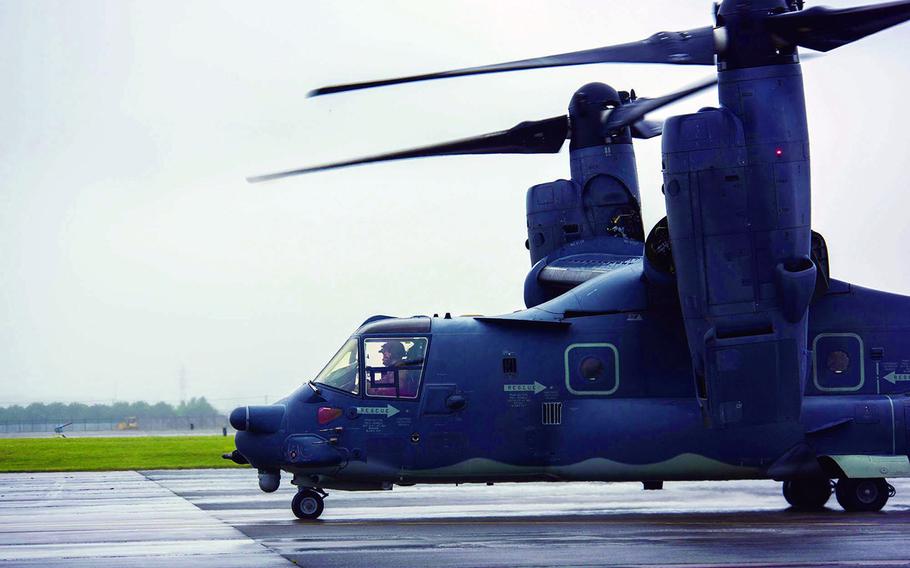
A CV-22 Osprey takes part in an elephant walk at Yokota Air Base, Japan, May 21, 2020. (Stars and Stripes)
TOKYO — Search-and-rescue efforts continued Thursday for an Air Force CV-22B Osprey that crashed the previous afternoon with eight aboard in southwestern Japan.
The tiltrotor aircraft — stationed at Yokota Air Base in western Tokyo and assigned to the 353rd Special Operations Wing — was on a routine training mission off Yakushima, an island in Kagoshima prefecture, when it went down, according to Air Force Special Operations Command.
“The cause of the mishap is currently unknown,” the command said in a statement released several hours after the incident. “The crew’s condition are unknown at this time.”
One of the eight crewmembers has been confirmed dead, a spokesman for the Kyushu Defense Bureau, an arm of Japan’s Ministry of Defense, said by phone Thursday.
The Osprey had been en route to Kadena Air Base, Okinawa, from Marine Corps Air Station Iwakuni near Hiroshima, he added. It’s customary in Japan for some government officials to speak to the media on condition of anonymity.
The individual recovered Wednesday was found near an empty, 20-person life raft and what appeared to be aircraft wreckage, a spokesman for Japan’s 10th Regional Coast Guard Headquarters said by phone hours after the crash.
The body was returned to the U.S. military on Thursday afternoon, a coast guard news release said.
Nothing was found during search-and-rescue efforts overnight, the coast guard announced in a news release Thursday morning.
It said the search was continuing with six patrol boats and two helicopters, along with vessels and aircraft from the Self-Defense Forces and the town of Yakushima.
The coast guard will also use side-scan sonar to capture images of the seabed, according to the release.
U.S. Ambassador to Japan Rahm Emanuel met briefly with Japan’s Foreign Affairs minister, Yoko Kamikawa, Thursday in Tokyo, according to a news release from the ministry. The pair committed to coordinating on the investigation.
Japan grounds its Ospreys
The Kagoshima Airport Office said an Osprey made an emergency landing request for Yakushima Airport at 2:38 p.m., according to a Yomiuri newspaper report.
A witness quoted by public broadcaster NHK on Wednesday said he saw the Osprey suddenly turn upside down and fire near its left propeller before it fell into the water.
Chief Cabinet Secretary Hirokazu Matsuno, during a news conference Thursday morning, called the incident tragic.
“Such accidents cause great concern to the residents living in the area and it is regrettable,” he said.
In the hours following the crash, Okinawa prefecture asked that Ospreys stop flying until the accident’s cause is identified, a prefectural spokeswoman who handles military affairs said by phone Thursday. The request was sent to the Ministry of Foreign Affairs, Okinawa Defense Bureau and Okinawa Liaison Office.
The Japan Ground Self-Defense Force grounded its Ospreys for the time being, Matsuno said, adding that the Japanese government has urged the U.S. side to confirm its tiltrotor aircraft are safe before flying them in Japan.
At least one U.S. Osprey has been in involved in the search-and-rescue efforts, Japanese defense officials told The Associated Press.
A Self-Defense Force training flight planned for Thursday was canceled as Japan grounded all 14 of its Ospreys, according to AP.
“First of all, we need to do our best to rescue the human life and continue to work to grasp the accident situation quickly,” Matsuno said.
‘Serious concerns’
Marine veteran Timothy Loranger, a Los Angeles-based attorney specializing in aviation law and military aircraft, said it will likely be at least a year before an investigation into the crash is concluded — a process that’s largely reliant on recovering the Osprey.
“Getting the aircraft back, starting an inspection of the aircraft systems — the flight systems record a lot of data, and hopefully that’s preserved,” he told Stars and Stripes by phone Wednesday. “If it involves material issues or engine issues, they bring in subject matter experts and determine what the cause was.”
Loranger said he’s concerned about ongoing issues with the Ospreys, pointing to a spate of mishaps over the past several years, including an Aug. 27 crash that killed three U.S. Marines in Australia.
“If you look at the hours that the aircraft has flown without a major mishap, it seems generally safe,” he said. “But there seems to be something going on with the aircraft and they haven’t been able to pinpoint the problem.”
Loranger said it’s too soon to draw conclusions about Wednesday’s crash, but he believes a serious review of the aircraft is warranted.
“The hope is that they are going to dig down and find the answers and resolve it,” he said. “Because, you know, with three crashes in a year and a half, there are serious concerns from people in the community.”
Stars and Stripes reporter Mari Higa contributed to this report.